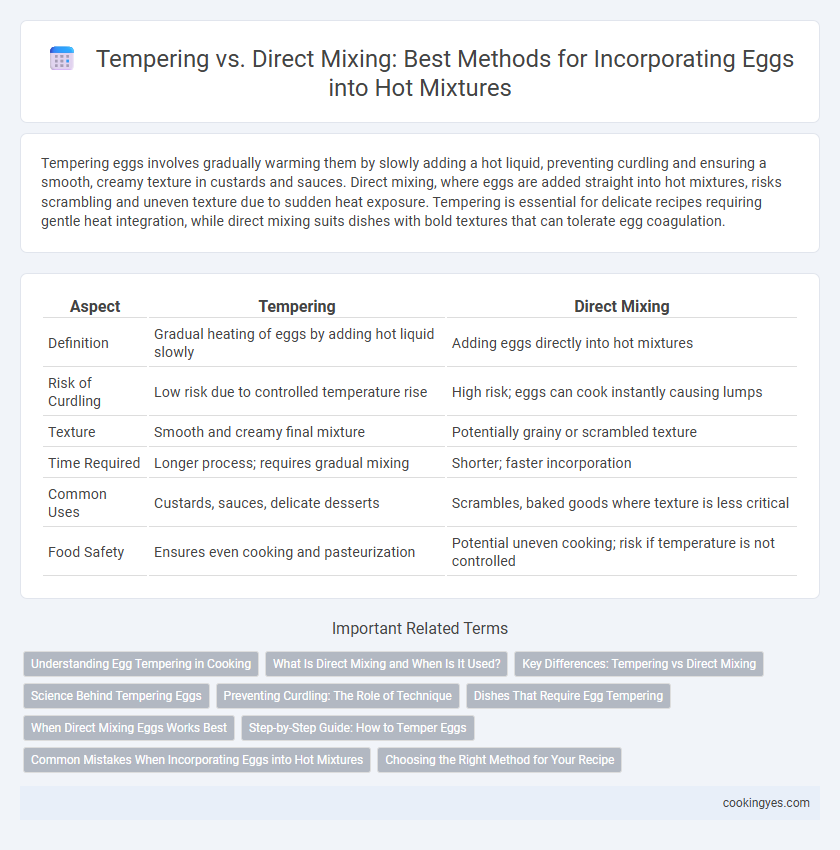Tempering eggs involves gradually warming them by slowly adding a hot liquid, preventing curdling and ensuring a smooth, creamy texture in custards and sauces. Direct mixing, where eggs are added straight into hot mixtures, risks scrambling and uneven texture due to sudden heat exposure. Tempering is essential for delicate recipes requiring gentle heat integration, while direct mixing suits dishes with bold textures that can tolerate egg coagulation.
Table of Comparison
| Aspect | Tempering | Direct Mixing |
|---|---|---|
| Definition | Gradual heating of eggs by adding hot liquid slowly | Adding eggs directly into hot mixtures |
| Risk of Curdling | Low risk due to controlled temperature rise | High risk; eggs can cook instantly causing lumps |
| Texture | Smooth and creamy final mixture | Potentially grainy or scrambled texture |
| Time Required | Longer process; requires gradual mixing | Shorter; faster incorporation |
| Common Uses | Custards, sauces, delicate desserts | Scrambles, baked goods where texture is less critical |
| Food Safety | Ensures even cooking and pasteurization | Potential uneven cooking; risk if temperature is not controlled |
Understanding Egg Tempering in Cooking
Tempering eggs involves slowly melding them with hot mixtures by gradually adding warm liquid to prevent curdling and maintain smooth texture, essential in custards and sauces. Direct mixing risks rapidly cooking the eggs, leading to uneven texture and potential lumps that compromise the dish's consistency. Understanding egg tempering enhances control during cooking processes like hollandaise or creme anglaise, ensuring optimal flavor and delicate, creamy results.
What Is Direct Mixing and When Is It Used?
Direct mixing involves adding eggs straight into hot mixtures without preliminary tempering, commonly used in recipes with gradual temperature increases where the risk of curdling is minimal. This method is preferred in custards, sauces, and batters where eggs cook evenly and quickly without requiring slow integration. Direct mixing streamlines preparation but demands precise temperature control to prevent scrambled eggs and ensure smooth texture.
Key Differences: Tempering vs Direct Mixing
Tempering involves slowly adding hot liquid to eggs to gradually raise their temperature, preventing curdling and ensuring a smooth texture in custards and sauces. Direct mixing introduces eggs immediately into hot mixtures, which can cause rapid coagulation and uneven cooking, often resulting in a grainy or scrambled texture. Key differences include temperature control and texture outcome, with tempering offering more precise heat management for delicate preparations.
Science Behind Tempering Eggs
Tempering eggs involves gradually raising their temperature by slowly adding hot liquid, preventing protein coagulation and curdling during cooking. This controlled warming preserves the eggs' smooth texture and prevents scrambled bits in custards or sauces. Direct mixing causes rapid protein denaturation, leading to undesirable grainy or lumpy textures in hot mixtures.
Preventing Curdling: The Role of Technique
Tempering eggs involves gradually adding a small amount of hot mixture to beaten eggs while constantly whisking, which gently raises their temperature and prevents sudden coagulation, reducing the risk of curdling. Direct mixing eggs into hot mixtures without tempering can cause rapid protein denaturation, leading to lump formation and a grainy texture. Proper technique in tempering stabilizes the eggs, ensuring smooth incorporation and maintaining the desired creamy consistency in sauces and custards.
Dishes That Require Egg Tempering
Egg tempering is essential for delicate dishes like custards, hollandaise sauce, and creme brulee to prevent curdling when eggs are combined with hot liquids. Direct mixing often causes rapid coagulation, leading to grainy textures and separation. Proper tempering ensures smooth, creamy consistency crucial for sophisticated culinary preparations.
When Direct Mixing Eggs Works Best
Direct mixing eggs into hot mixtures works best when preparing robust sauces or custards with moderate heat, where the risk of curdling is low. This method is ideal for dishes like scrambled eggs or quiches, where gradual temperature increases allow proteins to coagulate evenly. Ensuring eggs are at room temperature before mixing enhances emulsification and texture consistency.
Step-by-Step Guide: How to Temper Eggs
To temper eggs, slowly whisk a small amount of the hot mixture into beaten eggs to gradually raise their temperature without curdling. Continue adding the hot liquid in increments while constantly stirring to ensure even heat distribution. Once tempered, the warmed eggs can be safely incorporated back into the main hot mixture, creating a smooth and stable texture ideal for custards or sauces.
Common Mistakes When Incorporating Eggs into Hot Mixtures
Common mistakes when incorporating eggs into hot mixtures include adding eggs directly to boiling liquids, which causes curdling due to rapid protein coagulation. Failing to temper eggs by gradually mixing hot liquid into beaten eggs leads to uneven texture and scrambled bits in sauces or custards. Proper tempering stabilizes eggs by slowly raising their temperature, ensuring smooth incorporation and preventing coagulation.
Choosing the Right Method for Your Recipe
Tempering eggs involves gradually warming beaten eggs by slowly adding hot liquid, preventing curdling and ensuring smooth texture in delicate sauces or custards. Direct mixing is suitable for recipes where eggs are combined with cooler ingredients or baked goods, allowing for faster incorporation without the risk of scrambling. Selecting the right method depends on the temperature sensitivity of the recipe and desired consistency, with tempering ideal for creamy, heat-sensitive mixtures and direct mixing best for sturdier, baked preparations.
Tempering vs Direct mixing for incorporating eggs into hot mixtures Infographic

 cookingyes.com
cookingyes.com